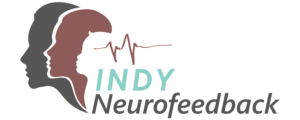There are five distinct brain waves:
Delta Waves – Produced when you are sleeping
Theta Waves – Produced when you start to fall asleep.
Alpha Waves – Produced during calmness and a sense of wellbeing.
Sensorimotor Rhythm (SMR) – Produced when completely still and focused on one particular task.
Beta Waves – Produced when alert and externally focused.
WHAT IS NEUROFEEDBACK?
Neurofeedback is also known as EEG Biofeedback. Neurofeedback is actually a learning modality designed to retrain dysregulated brainwave patterns. By doing this, the brain becomes more stable and is able to operate optimally and efficiently. It is completely noninvasive and is considered by the Food and Drug Administration to be safe. In fact the Food and Drug Administration recognizes that neurofeedback has NEVER produced a serious side effect since it was first discovered over 40 years ago. Neurofeedback cannot diagnose or treat any particular condition per se but peer reviewed, published research has demonstrated its efficacy in managing many neurological conditions such as ADHD, ASD, Migraine and Tension Headache, Insomnia, Chronic Pain, Post Stroke Syndrome, Anxiety and Panic Attacks as well as many others.

THE NEUROFEEDBACK EVALUATION PROCEDURE
Neurofeedback is guided exercise for the brain. All neurofeedback begins with a Quantitative Electroencephalogram (QEEG) evaluation. The QEEG is an assessment tool designed to objectively and scientifically evaluate a person’s brainwave patterns. The procedure consists of placing a snug cap on the head.
Embedded within the cap are 12 small sensors that are designed to measure and record electrical activity (or brainwaves) coming from the brain. It is important to note that these sensors do not put any electrical current into the brain – they simply record signals coming from the brain.
THE QEEG REPORT
The brainwave data recorded with the QEEG is statistically compared to a sophisticated and large normative database and a report is generated. This assessment procedure allows the technician to determine, in a scientifically objective manner whether a client’s brainwave patterns are different from normal. The QEEG assessment provides the technician with the neurofeedback training protocols that will be used during the training sessions. These protocols are designed to retrain the brainwave patterns toward normal. As the brainwave patterns normalize, the brain is able to operate more optimally and efficiently.
NEUROFEEDBACK TRAINING SESSIONS
Individuals are hooked up to a computer using wires and sensors and the computer records their brainwave activity. These sensors are noninvasive, as no electrical current is put into the brain. The sensors simply record the brainwaves coming from the brain. Information about these brainwaves is displayed on the doctor’s monitor.
The software automatically detects when the brainwaves are properly ordered and it feeds that information back to the client. This feedback appears in the form of a game, movie, or sound which signals the client that the brainwaves are becoming more ordered. As long as the client’s brain waves are moving in an orderly direction, the puzzle pieces are filled in and the client hears a tone. If the brainwave patterns move away from an orderly pattern, then the puzzle does not get filled in and no tone is produced. The client is actually controlling the completion of the puzzle with their brain and by doing so; the brain is learning how to regulate itself.
In another design, the client performs the training while watching a movie. In this case the client may watch a DVD movie that is being controlled by their ability to regulate their brainwaves. The movie will get brighter as the brain waves normalize and become darker when they become dysregulated. The brain’s natural desire to watch the movie clearly will drive those neurological circuits that normalize the brainwaves and allow the picture to be visualized. The more those circuits are driven and used – the more neuroplastic changes take hold. The client learns how to use those new circuits during the demands of everyday life.

